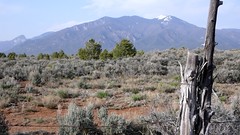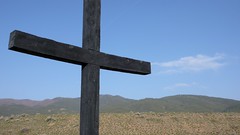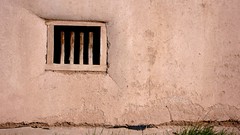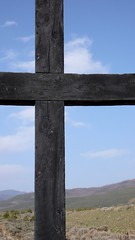
Back flat against the Mabel Dodge Luhan house in Taos, New Mexico, runs the sacred land of the Taos Pueblo. It’s hemmed in by a barbed wire fence, and if you follow it for awhile, to where it bends square and keeps on running, you’ll eventually come up against La Morada de Don Fernando de Taos, a crumbling adobe built probably in 1860 or so where the Penitentes worked super hard for their salvation, applying techniques and devices that are more commonly seen, anymore, in S&M joints.

The Penetitentes were flagellantes, possibly of a Franciscan order, who also very likely believed that:
Sin can only be expiated by suffering, and that forgiveness can most surely be obtained by self-inflicted torture. Particularly are they to follow the sufferings of the Saviour on Mount Calvary, to the foot of the cross; and sometimes even by being raised upon the cross itself. [1]

There barbed wire continues its run along the land occupied by the morada and then briefly, suddenly, narrowly jags onto the sacred pueblo.
This is where (I was told) the Penitentes made their run with cat o' nine tails in hand, sometimes carrying the charred black cross that stands at the outset of the path, maybe stopping at any of the many stone crosses that are inset in the earth.
Their goal was its twin and counterpart, a white cross of the same immense proportions, some distance away down the thin sacred red sangre de cristo earth trail.

They weren't permitted to step off the trail. This was all they were allowed of the sacred land.
I’m told too that this is where Georgia painted her cross.

You Spaniards and Christians are crazy and desire us to be so also. You are so crazy that you go along through the streets lashing yourselves like madmen, shedding blood.
— An “Indian Wizard”, or more likely a Medicine Man, as quoted by Benavides in his 1630 report to the King of Spain

[1] This and the other citation are both from Spanish Mission Churches of New Mexico by L. Bradford Prince, LL.D. (Books of the Southwest: The University of Arizona Library)






No comments:
Post a Comment